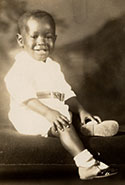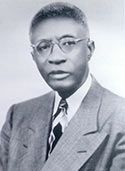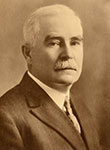Houston – A Place to Practice (1927-1954, Section 2)
1927
With the completion of Houston Negro Hospital in May 1927, Houston offered something many southern cities did not: a state-of-the-art facility for African-American patients and an institution in which African-American physicians practiced their chosen profession. Carter Wesley, a lawyer and native Houstonian, had used the opportunities afforded by the hospital to lure Dr. George Patrick Alphonse Forde to Houston.
Moreover, the physicians on staff at the Houston Negro Hospital continued to improve the quality and scope of the services offered there. Joseph Cullinan’s continued support was essential to their efforts. In 1931, he funded an educational and residence building for black nursing students. Following his death in 1936, Mr. Cullinan’s estate provided the hospital with an endowment of more than $500,000.
Houston Negro Hospital also was a place where African-American physicians continued their training by working with other, more experienced doctors. This opportunity was particularly important because in the early decades of the century, only eleven hospitals in the nation allowed African-Americans to intern. Because of such restrictions, only sixty percent of the 1,051 southern black physicians had been accepted for an internship, according to surveys between 1928 and 1934.
In turn, no physician in the United States was admitted to a residency for specialized training unless he or she completed an internship. The forty percent of African-American physicians who completed internships discovered that very few hospitals were willing to accept them in residency programs, thus making more specialized training difficult. Upon completing a residency, a doctor took a series of written and practical tests, called boards.
It was not unusual for physicians to need to repeat part of their boards because of the difficulty of the tests. When a physician passed the boards, he or she became board certified, and was regarded as an expert in his or her given specialty. Excluded from virtually all residency programs before the 1950s, only a fraction of African-American physicians were specialists. Arriving in Houston in the early 1940s, Dr. T.A. Fletcher was one of the first board-certified black doctors, having completed an ophthalmology residency and passed his boards.
Consequently, most black doctors in Houston before 1950 were general practitioners who worked diligently to remain current in the rapidly changing profession of medicine. Many of these physicians took extra courses in or focused their practices in particular areas of medicine.
1924
Dr. Thelma Patton Law, who was educated in the Houston public schools, returned home in 1924 after completing her medical degree at Howard University Medical School and her internship at the Freedmen’s Hospital in Washington, D.C., where she also received an honor certificate in gynecology. Dr. Law was the first female African-American doctor in Houston. Her practice focused on Obstetrics and Gynecology, addressing in particular the needs of Houston’s poor women for more than forty years. Among other activities, she helped establish the Planned Parenthood Center in 1935 and its clinic in 1939.
Dr. Charles Whittaker Pemberton, a native of Marshall, Texas, and a veteran of World War I, joined Dr. Law in 1926 after completing his internship at the St. Louis City Hospital, one of the eleven institutions that accepted black doctors. In 1924, Dr. Pemberton had studied public health at the University of Michigan in Ann Arbor. Two years later he moved to Houston, practicing there for the next forty-five years. Among other important positions, Dr. Pemberton became the first black member of the Houston Independent School District’s Health Department, a position he held for 37 years.







